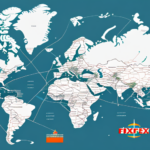Importance of Expanding Your Ecommerce Business Internationally
The global ecommerce market has surpassed $5.7 trillion in sales in 2022 and is projected to continue growing in the coming years [source]. This substantial growth is driven by the increasing number of online shoppers worldwide, particularly in emerging markets such as China, India, and Brazil. Expanding your ecommerce business internationally allows you to tap into this vast customer base, significantly increasing your revenue streams. Additionally, international expansion helps diversify your customer base, reducing reliance on any single market or region and mitigating risks from economic downturns or market saturation.
Furthermore, expanding internationally can provide a competitive advantage. By entering new markets, you can offer unique products or services that may not be available locally, helping your business stand out from competitors. International expansion also offers valuable insights into new trends and customer preferences, fostering business growth and development.
Planning Your International Expansion
Conducting Market Research
Before expanding internationally, conducting thorough market research is essential. This process helps identify viable markets and assess the feasibility of expansion into different regions or countries. Key factors to consider include the size and growth potential of the ecommerce market, consumer preferences and behaviors, competitive landscape, logistics and shipping costs, and regulatory and legal requirements.
Additionally, understanding cultural differences is crucial. Cultural nuances can significantly impact consumer behavior and preferences. For instance, certain colors or symbols may carry different meanings across cultures, influencing how your brand and products are perceived. Language barriers are also important to address, especially in non-English-speaking regions. Investing in translation services or hiring local staff fluent in the target language ensures that your marketing messages and product descriptions are accurately translated and resonate with local consumers.
Creating an Expansion Plan
After identifying international opportunities through market research, the next step is to create a comprehensive expansion plan. This plan should outline clear objectives, timelines, budgets, and resource allocation. It should also identify potential challenges and risks, such as high logistics and shipping costs, complex legal and regulatory requirements, and cultural differences. A well-defined plan helps maintain focus and make informed decisions throughout the expansion process.
Localization is a critical aspect of your expansion plan. This involves adapting your products or services to meet the specific needs and preferences of the target market. Localization may include translating your website and marketing materials, adjusting product features or packaging, or altering your pricing strategy. By tailoring your offerings to the local market, you can enhance your chances of success.
Developing a Pricing Strategy
Establishing an appropriate pricing strategy for international markets is vital. Factors to consider include local competition, currency exchange rates, shipping and customs duties costs, and local purchasing power. Conducting local market research and analyzing pricing data can help optimize your pricing strategy for each market. Additionally, understanding cultural attitudes towards pricing can inform whether to adopt fixed prices or accommodate practices like bargaining, enhancing customer appeal and sales.
Operational Considerations for International Expansion
Logistics and Shipping Challenges
Expanding internationally poses significant logistics and shipping challenges. International shipping costs can be substantially higher than domestic shipping, and navigating varying regulations, paperwork, and customs procedures across countries can be complex. To minimize costs and delays, consider partnering with local logistics providers or utilizing third-party service providers that specialize in international shipping and delivery.
Cultural differences can also impact logistics operations. Different countries may have unique holidays and peak shopping seasons that affect shipping and delivery schedules. Additionally, packaging and labeling requirements may vary, necessitating adjustments to comply with local regulations and customer expectations. Effective management of these factors ensures a smooth logistics process and enhances customer satisfaction.
Navigating Legal and Regulatory Requirements
International expansion requires compliance with a myriad of legal and regulatory requirements, including tax laws, customs regulations, data protection laws, and consumer protection standards. Thoroughly researching and understanding the legal landscape of each target market is essential to avoid legal pitfalls. Securing the necessary licenses and permits to operate in each country is also a critical step. Collaborating with local legal experts or advisors can provide valuable guidance through the complexities of international regulations.
Leveraging Technology
Technology plays a pivotal role in facilitating international expansion. Utilizing ecommerce platforms that support multiple languages, currencies, and payment methods can streamline the user experience for international customers. Automation tools for order processing, inventory management, and shipping can increase efficiency and reduce operational costs. Additionally, leveraging data analytics can provide insights into customer behavior, helping to tailor marketing strategies and optimize product offerings for each market.
Marketing and Localization Strategies
Adapting Your Marketing Strategy
Effective marketing is essential for success in international markets. Adapting your marketing strategy involves tailoring your campaigns to fit the local culture and consumer preferences while maintaining a consistent brand message. This may include translating website content and product descriptions, creating localized marketing campaigns, and leveraging local social media platforms and influencers. Understanding the local media landscape and consumer behavior helps in crafting marketing strategies that resonate with the target audience.
Overcoming Language Barriers
Language barriers can significantly hinder effective communication with international customers. To overcome this, consider localizing your website and product pages by translating them into the native languages of your target markets. Accurate and culturally appropriate translations are crucial for conveying your message clearly. Partnering with professional translators or localization agencies can ensure that your translations are of high quality and culturally relevant, enhancing the overall customer experience.
Understanding Cultural Differences
Cultural differences can influence consumer behavior and perception of your brand. Being aware of local customs, traditions, and taboos is important to avoid cultural missteps that could harm your brand's reputation. For example, color meanings, symbolism, and product preferences can vary widely across cultures. Conducting cultural research and seeking local insights can help you design products and marketing materials that are culturally appropriate and appealing to the local audience.
Building the Right Team and Partnerships
Building an International Team
Having a diverse and international team can provide invaluable insights into local markets and cultures, facilitating smoother expansion. Hiring team members who are familiar with the local market can help navigate cultural nuances, language barriers, and operational challenges. An international team can also contribute to more effective communication, marketing, and customer service tailored to each region.
Partnering with Local Experts
Forming partnerships with local experts, including distributors, agents, and consultants, can significantly ease the process of international expansion. Local partners bring in-depth knowledge of the market, established networks, and understanding of regulatory requirements. Collaborating with these partners can help you navigate complex market dynamics, establish a local presence, and build trust with customers more quickly.
Measuring Success and Avoiding Common Mistakes
Key Performance Indicators
Measuring the success of your international expansion efforts is essential for ongoing optimization and strategic decision-making. Key performance indicators (KPIs) to track include international sales revenue, conversion rates, shipping costs, website traffic from different international markets, and customer satisfaction levels. Monitoring these metrics helps identify areas for improvement and assess the effectiveness of your expansion strategies.
Case Studies: Successful Examples
Studying successful examples of ecommerce businesses that have expanded internationally can provide valuable insights and strategies. For instance, Amazon has successfully launched its platform in multiple countries, including the UK, India, and Japan, adapting to local market needs and regulations. Another example is ASOS, a fashion retailer that generates over 60% of its revenue from international sales by catering to diverse markets. Analyzing these case studies can help you understand best practices and strategies for your own expansion.
Common Mistakes to Avoid
When expanding internationally, it's crucial to avoid common pitfalls that can impede your success. Some of these mistakes include underestimating the local competition and market demand, neglecting cultural differences and local customer preferences, failing to adapt marketing messages and visuals, not investing in local logistics and shipping solutions, and not complying with local legal and regulatory requirements. Conducting thorough market research, developing a solid expansion plan, and collaborating with local experts can help prevent these mistakes and ensure a successful international expansion.
Conclusion
Expanding your ecommerce business internationally requires meticulous planning, strategic execution, and ongoing optimization. By implementing the strategies and steps discussed in this article, you can effectively navigate the complexities of international markets, mitigate risks, and capitalize on the vast opportunities presented by global ecommerce. Embracing international expansion can propel your business to new heights, ensuring sustained growth and a robust global presence.






















